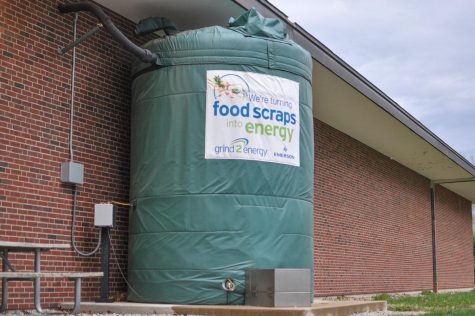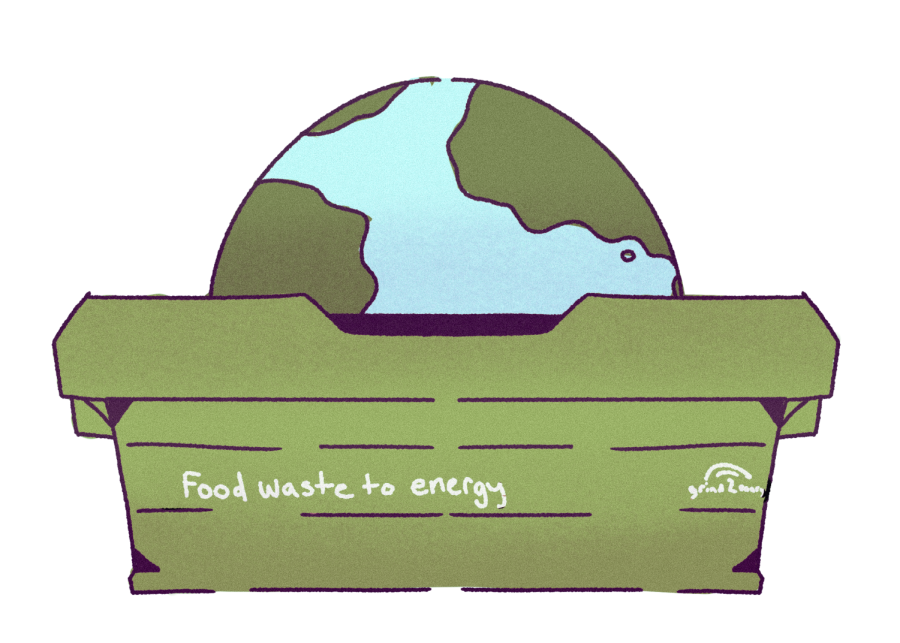Grind2Energy: A system for making food greener
Apr 20, 2022
Last updated on Oct. 15, 2023 at 03:03 p.m.
According to the United States Department of Agriculture, up to 40% of all food in the U.S. is wasted. In the University dining halls, food waste is only at 2%. Since 2019, the University dining halls and the Urbana & Champaign Sanitary District have been repurposing food waste into energy and fertilizer using a system called Grind2Energy.
After food is put in the green bins at the dining halls, it is taken into the kitchens, mixed with water and put into a grinder. The result is a semi-liquid mixture called slurry, which is then pumped out to a several thousand-gallon holding tank outside the dining halls. When the tank hits 80% capacity, the slurry is picked up and transported to the Urbana & Champaign Sanitary District.

Wade Lagle, the operations supervisor at the sanitary district, explained what the district does with the slurry.
“From there, we directly feed it into a blending tank … and then we store it for three to five days,” Lagle said. “We blend it with several other waste streams. Food waste (from the University) is only about 0.2% of our feedstock to our digesters on an annual basis.”
Get The Daily Illini in your inbox!
Lance Charles Schideman, the principal research scientist at the Illinois Sustainable Technology Center, said the next step is anaerobic digestion.
“There’s a natural set of microorganisms that occur in anaerobic (oxygen-free) situations … which breaks down the organic matter (food waste) into … flammable fatty acids,” Schideman said. “Then, they’re subsequently broken down into methane and CO2 … which together are called biogas.”
Lagle said the methane contributes to 30% of the district’s daily total power. The leftover sludge from the slurry becomes a 20% to 25% solid material that is used as fertilizer for agricultural fields.
Thurman Etchison, assistant director of dining at the University said that before Grind2Energy, the dining halls were doing something different with their waste.
“Prior to G2E, we were using aerobic (with oxygen) digesters … it would take our food waste and turn it into grey water,” Etchison said. “It had microbes in a holding tank that was constantly stirred, and they (microbes) would eat the food.”
Schideman explained why the prior system was not a practical solution.
“The aerobic digestion process … takes the energy content (in the waste) and turns it into CO2,” Schideman said. “It’s a double negative because it gets rid of the energy, and it takes energy to do that process.”
Etchison said he knew it was time for something better.
“About four years ago, we were in the planning stages for ISR and talking to the sanitary district. We did some testing on the free flow that was coming out of those machines and found it didn’t meet the EPA guidelines,” Etchison said. “We decided we needed to change gears.”
Etchison said the Grind2Energy systems were put in Ikenberry, ISR, FAR and PAR. He also said that currently, waste from Lincoln Avenue dining halls goes to PAR, but there are plans to install a fifth tank there over the summer.

The system doesn’t just service the University. It is a nationwide program aimed toward large-scale food serving operations. Heather Dougherty, the business development lead for Grind2Energy, explained why it was created.
“It was around 2010 that our leadership … (was) really recognizing the need for commercial foodservice operations to have an alternative solution for managing their food scraps,” Dougherty said. “We had our first prototype out in 2012.”
Dougherty elaborated on the system’s current range of services. She said they work with hotels and grocers, and they can keep track of the systems using a database.
“Our environmental team has a very comprehensive Google Maps database of every (anaerobic) digester in the U.S.,” Dougherty said. “So when a customer reaches out to us, we can access that map and know where the digesters are.”
Dougherty first encountered massive food waste when she was working in sports and entertainment.
Like Dougherty, many are concerned about food waste levels and want to make changes, but Schideman explained that it can be difficult to balance energy expenses and profits.
“The main challenge is the collection mechanism … if you try to go around to every house and get their food waste, capture it, carry it somewhere and then do anaerobic digestion, you may spend more energy on the collection than you end up getting,” Schideman said.
Lagle said many companies do not choose renewable energy systems because of the hefty costs.
“That is usually the hurdle that people can’t get past. To make a capital investment without the payback within a reasonable time frame is hard to do,” Lagle said. “Even with our heat and power units, the payback on them is roughly 10 years.”
While it isn’t easy to fix this issue on the business end, Etchison said students have the ability to make a difference. He explained how a good portion of students take more food than they can eat and sometimes, students do not throw their scraps in the Grind2Energy bins.
“I worry about the kind of environment we leave for our grandchildren. Consider everything that went into that food,” Etchison said. “We bring it here, we refrigerate it, we cook it, we prepare it, we add water. All along the way there’s energy and water and other resources being used,” Etchison said. “And some of it just gets thrown out.”






